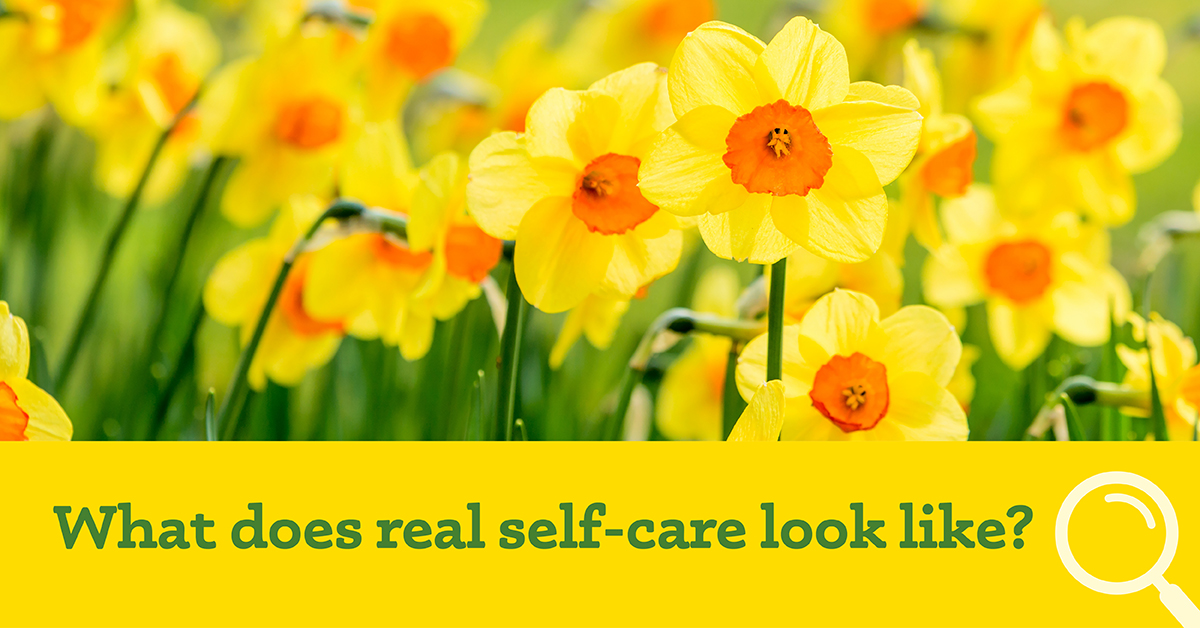Real self-care – Brain Tumour Awareness Month 2021
For Brain Tumour Awareness Month, we’re looking into the theme of self-care and how it can be transformative for people with a brain tumour. Understanding what self-care is (and what it isn’t!) can build resilience, happiness and make it easier to face the road ahead.
What do we mean by ‘real self-care’?
We’re moving beyond the bubble baths and scented candles you see advertised on Instagram. Real self-care can be transformative in helping you rest and recharge, connect to your inner self and live a life that is aligned with your values.
Having said this, we are definitely not anti-bubble bath! Making the conscious decision to take time out for yourself and prioritising your relaxation are definite reasons why bubble baths are a legitimate self-care practice. What we’re focusing on for Brain Tumour Awareness Month, however, is the self-care that dives a little deeper.
In our ‘Beyond the Bubble Bath’ webinar on 30th March, we’ll explore this topic. Together we’ll look at the science behind happiness, why so many of us feel unfulfilled and why we can end up feeling like the grass is greener on the other side. And after we’ve explored the psychology, we’ll look at practical strategies to help you discover authentic happiness when living with a brain tumour.
Check out the rest of our online events this month, curated to help you live better with a brain tumour.
Self-care is often spoken about, particularly on social media, in the context of short-term pleasure. This ‘treat yourself’ mentality puts the emphasis on making decisions that feel good right now. This could be an impulse purchase, or staying in bed scrolling on your phone after your alarm goes off. Things like this feel tempting at the time, but often they can leave us feeling guilty or disappointed. If you can relate to this, you might benefit from some ‘real self-care’.
Here, we’re talking about activities and strategies that can help improve your happiness and well-being in the long term. We’ll explore some examples of these below.
Self-care when you have a brain tumour
Self-care takes on another level of importance when you are living with a brain tumour. Below, we’ll explore some relevant self-care practices and how they can specifically benefit people affected by a brain tumour.
Living well with fatigue – establishing a night-time or morning routine
Managing fatigue is a complicated topic. Even the best habits in the morning and evening won’t eradicate it’s impact on your life. However, good night-time and morning routines can help you to minimise the impact of fatigue on your life.
You can read our guide to sleeping better here, and find our Fatigue Resource here.
Just one self-care practice you could try is limiting screen time before bed. It is well-known that blue light can impact our sleep quality. Do you often find yourself tempted by a night time scroll? Why not leave your phone in a drawer (or even in another room) an hour before bed? Instead of scrolling, listen to a podcast, read a book, chat with your loved ones or try some journalling.
Reflecting on your emotions and figuring out your needs through coaching
A brain tumour diagnosis forces you to make big changes to your life and can require you to make incredibly personal and difficult decisions.
Coaching can help you to accept the reality of your diagnosis, and help you articulate your priorities. From this place, it is easier to make difficult decisions, accept the unknown and make peace with the outcomes, because you are living a life that reflects your values and priorities.
brainstrust offer free coaching to people with a brain tumour and their loved ones. To find out more and to organise a coaching call with one of our trained support specialists, email hello@brainstrust.org.uk.

Joyful movement
We know that regular exercise is good for us for all sorts of reasons. Physical health and fitness are obvious answers, but evidence shows that exercise reduces stress and improves mental health too. If a home workout or a run isn’t possible for you (or doesn’t appeal to you, which is totally valid too!), there are other ways to reap the benefits of exercise. Dance around the kitchen to your favourite song, or take a walk in the park. When we remove the pressure of comparison to others, and focus on what we enjoy, it is far easier to build a habit and therefore enjoy the many benefits of an exercise routine!
Setting boundaries
This is a perfect example of how real self-care sometimes feels uncomfortable in the moment, but can have a positive outcome for you long-term.
Articulating your needs can feel very scary and can sometimes lead to people being defensive. It can be tempting to sweep our feelings under the rug to avoid ‘causing a fuss’. We shouldn’t do this – healthy boundaries are a crucial component of self-care. That’s because “in work or in our personal relationships, poor boundaries lead to resentment, anger and burnout” (Nelson, 2016).
Here are some examples of when you might need to set a boundary with your loved ones when you have a brain tumour.
- Say you are experiencing brain tumour related fatigue. Sometimes, friends and family don’t understand its intensity or severity. They can expect you to carry on with activities that you would have done before your brain tumour. Setting a clear boundary that when you feel the need to rest, you will rest, and that comments around what you “used to be able to do” are unhelpful, will mean that you can look after yourself, focus on your rest and recovery, and not feel pressured to live up to anyone else’s expectations.
- Having a brain tumour can make you more reliant on your loved ones than before. Examples might be during and following treatment, or if you have to surrender your driving license. What boundaries could you put in place to maintain a sense of independence and autonomy? Articulating these to your loved ones will benefit everyone.
If you’d like some help in setting boundaries with your loved ones, come along to one of our Meetups to talk to others, or call us on 01983 292 405.
Exploring your creativity – even when you don’t feel like a ‘creative person’
It’s all too easy to spend your time making sure the people around you are OK, but you need to make time for yourself, too. In these moments where you prioritise yourself, you have a unique opportunity to check in with yourself and reflect on what brings you joy.
When we are engrossed in a hobby or activity, without even realising, we are practicing mindfulness! Stresses and worries disappear as we focus on the task at hand. Maybe you love cooking, jigsaws or painting – whatever it is, make sure that you slot time in every week to focus on yourself and the things that make your heart sing.
There are so many benefits to practicing creativity. From improving problem-solving skills, to reducing anxiety, even complete beginners can find calm and enjoyment in creative practice.
Read about how creativity has helped Lou on her brain tumour journey, here.
The Great brainstrust Create-Off is your chance to share your creativity with the brain tumour community. Find out more here!












